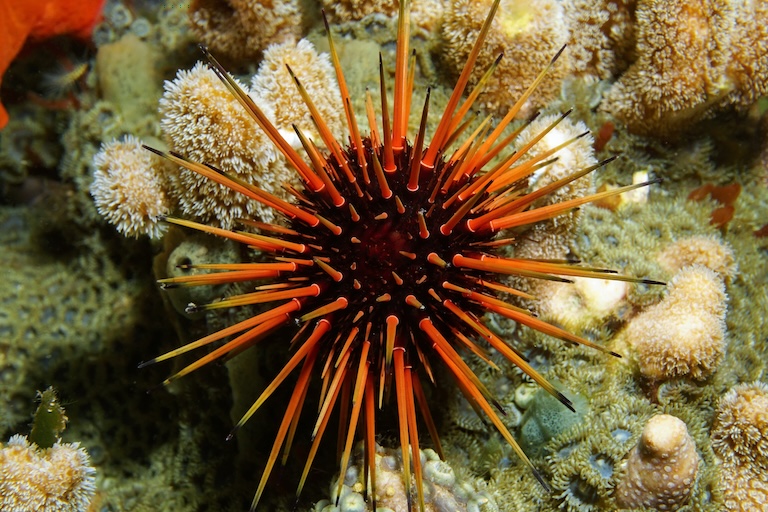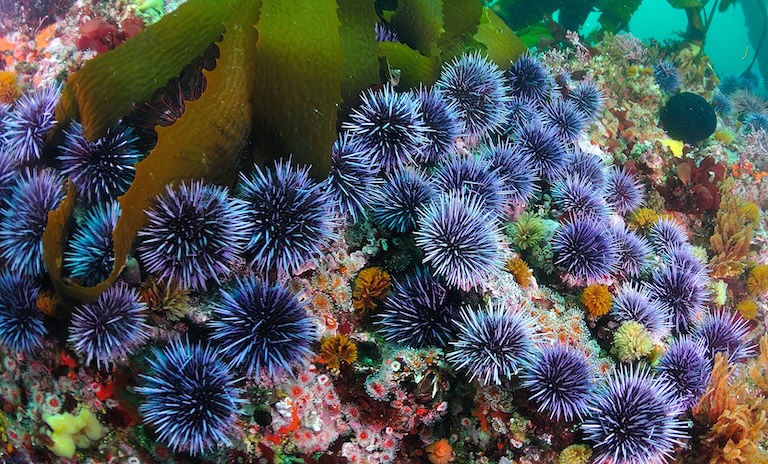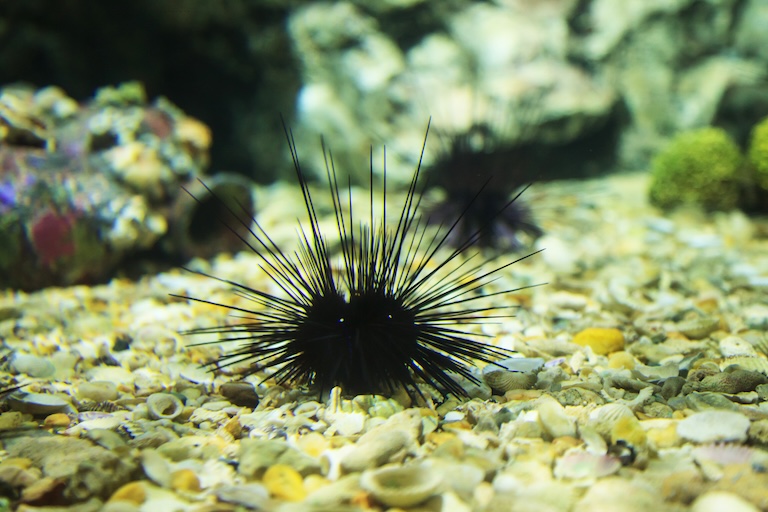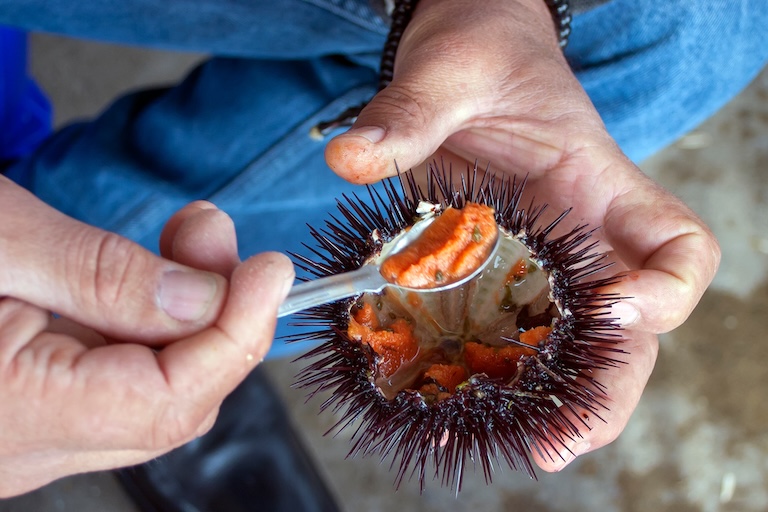Urchin Profile
Somehow, the word Urchin became a Dickensian slur for a homeless kid, and this doesn’t make a lot of sense.
Aside from the fact that they’re small and can stab you, there aren’t many similarities between the two, as real urchins are some of the oldest animals you’ll ever see, clean up after themselves and don’t taste remotely like their terrestrial namesakes.

Urchin Facts Overview
| Habitat: | Benthic marine, from shallow to deep sea |
| Location: | Everywhere! |
| Lifespan: | 100 years or more |
| Size: | 3cm to 30 cm |
| Weight: | Varied |
| Colour: | Usually reds and browns but highly variable |
| Diet: | Algae, detritus |
| Predators: | Otters, sharks, starfish |
| Top Speed: | Very slow |
| No. of Species: | 1000+ |
| Conservation Status: | Most are doing fine, some are endangered |
Urchins are a very old line of marine spiny creatures with lots of feet, articulating spines and a mouth that drew comment from Aristotle himself.
They are found in every marine system in the world, having dominated the seabed for over half a billion years. They come in almost all colours and sizes but there really is more or less only one shape. Round.
Still, these spectacular creatures are perhaps marginally more closely related to us than you might think!
Interesting Urchin Facts
1. They’re Bilaterals
Ye olde scientific taxonomy style is very quaint in its ignorance and really fun to read, but there are areas in which our modern style still echoes the past.
Aristotle was the first to start grouping things, and this system was so successful that it was carried well into the Middle Ages. He separated animals into the blooded – that is, those that obviously bleed – and the bloodless, among many other groupings.
Today, this clever, early observation isn’t anywhere near detailed enough for modern science, but we do still have some similarly vague-seeming categories that belie our enduring ignorance, and one of them is the Bilateria: one of five ways that life appears to be separated. This group is defined by its appearance of having been mirrored down the middle.
We’re bilaterians, as we typically have much the same on our right side as we do on our left, but not (hopefully) the same on the front as the back.
Other animals are radially symmetrical, like jellyfish, whose left and right sides can’t really be ascertained and are instead symmetrical around a centre point. Urchins appear to be radially symmetrical: they’re round, they have five similar segments, and you can’t tell which way they’re facing.
But from looking at their larvae, who are split down the middle, it’s believed that these, too, are bilaterians. So, they’re one of us! Their young also develop from eggs arse-first, like we do, making them deuterostomes.
Having said this, they’re about as far from us as you can find in this category.

2. They’re echinoderms
Echinodermata. What a wonderful phrase. This is the phylum of animals that urchins belong to, and it’s positively ancient. It translates to “Hedgehog Skin” which is pretty apt for the spiny urchins, but they diverged from the ancestors of real hedgehogs around half a billion years ago.
The echinoderms are also where you find starfish and sea cucumbers, which, ironically, are more ancient than land cucumbers.
Among team Arse First, this phylum is second only in diversity to the chordates – our phylum – for which we can primarily thank the ray-finned fishes, who make up more than half of that.
Like starfish, urchins have hundreds of little tube feet for moving around, and they are grouped at the class level, by the name of Echinoidea. But we can go deeper, as urchins are incredibly diverse too!
3. Some are irregular
Like people with varying amounts of fibre in their diets, urchins can be divided into irregular and regular types.
These are subclasses, and the majority of what we think of when we say sea urchin fit within the Carinacea, or regular subclass. They’re round, mostly spiny, and classic urchin-shaped. The irregular urchins are within irregularia, which is a great name, and these contain the sand dollars, which are flat, burrowing urchins and very cool animals.
But there’s a third group, too, and these are the cidaroids, or pencil urchins. These are similar to regular urchins but with thicker spines, more sparsely spread over the body. These are the only order of a very ancient subclass of urchins who mostly died out during the reign of the dinosaurs.
4. They can be pretty big
Most urchins we’re familiar with are between 5 and 10cm across, and these are commonly the kind that get shards stuck in our feet.
Some get even smaller, to around 3cm across, but at the other end of the spectrum are animals like the red sea urchin and the heart sea urchin, both of which grow to more than 20 cm across, and there are some deep-sea mysteries like Sperostoma giganteum that may well get bigger than this. 1
5. Aristotle’s Lantern
Urchins weren’t overlooked by Aristotle himself, who described urchins and their strange mouths as follows:
“In reality, the mouth-apparatus of the urchin is continuous from one end to the other, but to outward appearance it is not so, but looks like a horn lantern with the panes of horn left out.”
And as a tribute to Science’s earliest taxonomist, this mouth shape is still referred to as Aristotle’s Lantern. This five-sided scraper is used to gather algae off feeding surfaces, which is about all the urchin ever does, and what all of those spiny blobs are likely doing when you see them dotted about on the rocks.
Unfortunately, urchins have not yet developed an understanding of the law of holes, the main one being that when you find yourself in one, stop digging. 2

6. They can get stuck
When this scraping by the lantern is continuous enough, it can bore through soft rock until the urchin finds itself at the bottom of a long, cylindrical hole.
This doesn’t necessarily bother the urchin, who can still get by with the detritus floating about in the water, but for saltwater aquarium enthusiasts, it can require the owner to pluck them out of their predicament and reset them on the rock.
7. Their teeth don’t blunt
Urchin teeth are, strangely enough, made out of more or less the same stuff as the rocks they scrape, yet somehow, they’re significantly harder and don’t wear out very easily at all.
It turns out, they’re formed out of a derivative of the calcite that forms the rock, and one that contains hard and small magnesium calcite crystals. Like a diamond-tipped blade, these hardened crystals are focused on the cutting edge of the teeth, and this acts as a grinding surface for the urchin to scrape with. 3
8. Some can kill
Most urchins offer no worse than an unpleasant wood splinter in the foot. In fact, many beachside cultures around the world use urchins as a food source.
But others can be extremely dangerous, like the misleadingly-named flower urchin.
This species has very toxic venom that causes immense pain and potential paralysis in those who are stung by it. Only a few stings have been documented, but it’s assumed that this urchin has a serious potential to cause death if enough of the toxins make it into the body.
On the other hand, of those that are commonly eaten, at least one is now in danger of disappearing forever. 4
9. Others are dying out
In Sicily, the immense culinary pressure of tourism has forced some species of urchin into dire straits.
Overharvesting of urchins has led to a worrying decline in their numbers, and politicians have proposed bans and limits on the practice. But if there’s one thing Italians are most stubborn about, it’s their food, and despite bans in places like Puglia, illegal harvesting continues. 5 6

Urchin Fact-File Summary
Scientific Classification
| Kingdom: | Animalia |
| Phylum: | Echinodermata |
| Class: | Echinoidea |
Fact Sources & References
- Deep Marine Seas, “Red Sea Urchin”, Youtube.
- The Marine Detective (2020), “Aristotle’s Lantern”, The Marine Detective.
- (2009), “True Grit: How Sea Urchins Carve Hiding Holes in Limestone”, Science Daily.
- , “Toxopneustes pileolus”, Wikipedia.
- Margarita Diaz, “The Battle Over Puglia’s Sea Urchins: A Delicate Delicacy at Risk”, Italy Segreta.
- Lorenzo Tondo (2023), “Sea urchin in Sicily at risk of extinction due to popularity as culinary delicacy”, The Guardian.
